Executive Assessment: Communication, Auditing, and Financial Decisions
VerifiedAdded on 2021/05/31
|10
|1887
|22
Report
AI Summary
This report provides an executive assessment of key communication matters within the context of new auditing standards. It explores how audit reports influence investor decisions, emphasizing the importance of transparency through clear communication of key audit matters. The report analyzes organizational management performance measurement, including data collection, performance indicators, and the impact of performance-based incentives. It examines compensation contracts of executives, including short-term and long-term incentives, and how these are determined by performance metrics and agency theory. The report also assesses the role of bonus plans in mitigating agency problems, discussing risk aversion, dividend retention, and horizon value. Furthermore, it offers recommendations for a lending officer, including safeguards related to loans, NPA classification, internal control, and audit report consideration, along with standard procedures, laws, credit scores, and managerial remuneration. The report draws upon various academic sources to support its findings, offering a comprehensive overview of financial and auditing practices.

l 2018
Paraphrase This Document
Need a fresh take? Get an instant paraphrase of this document with our AI Paraphraser
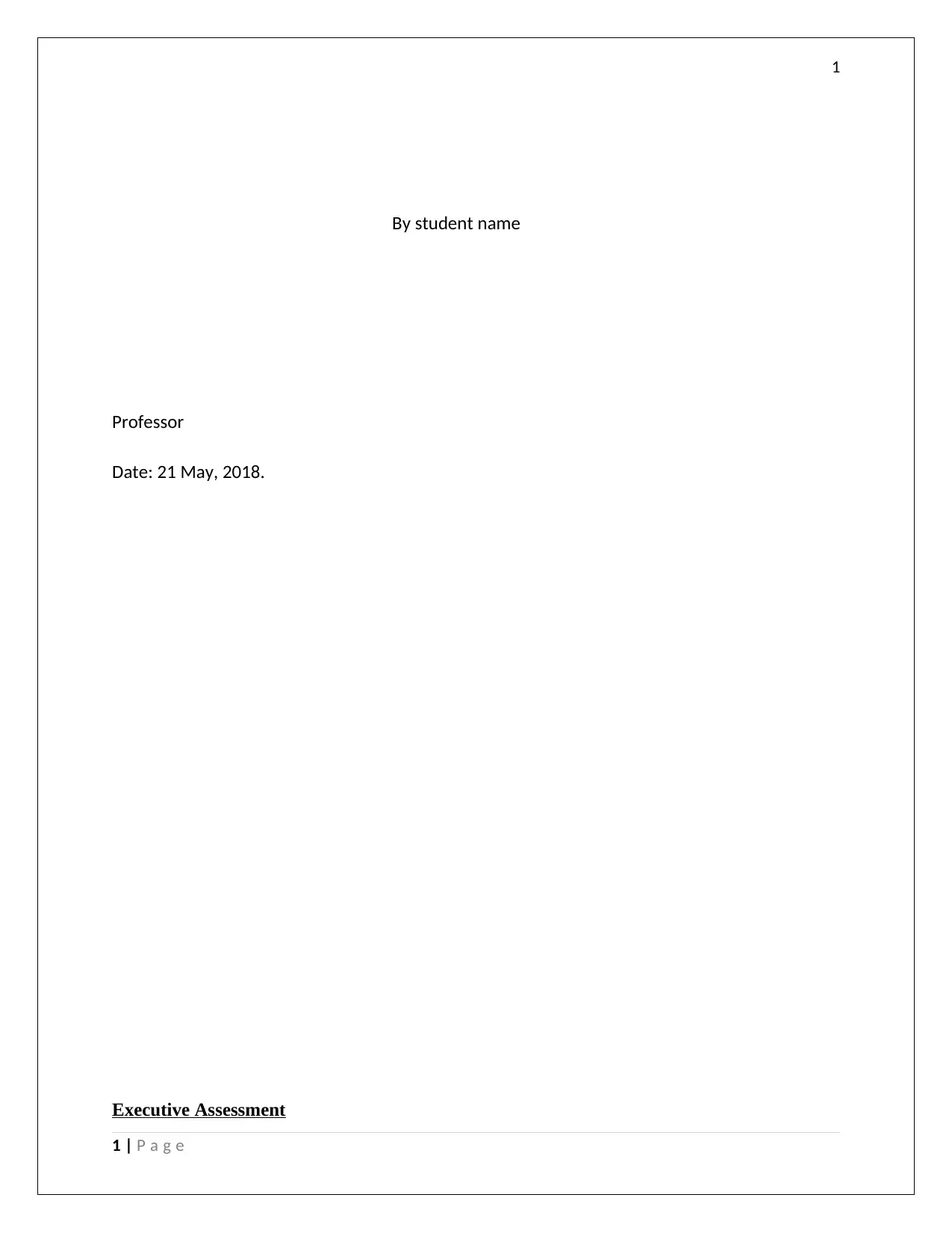
1
By student name
Professor
Date: 21 May, 2018.
Executive Assessment
1 | P a g e
By student name
Professor
Date: 21 May, 2018.
Executive Assessment
1 | P a g e
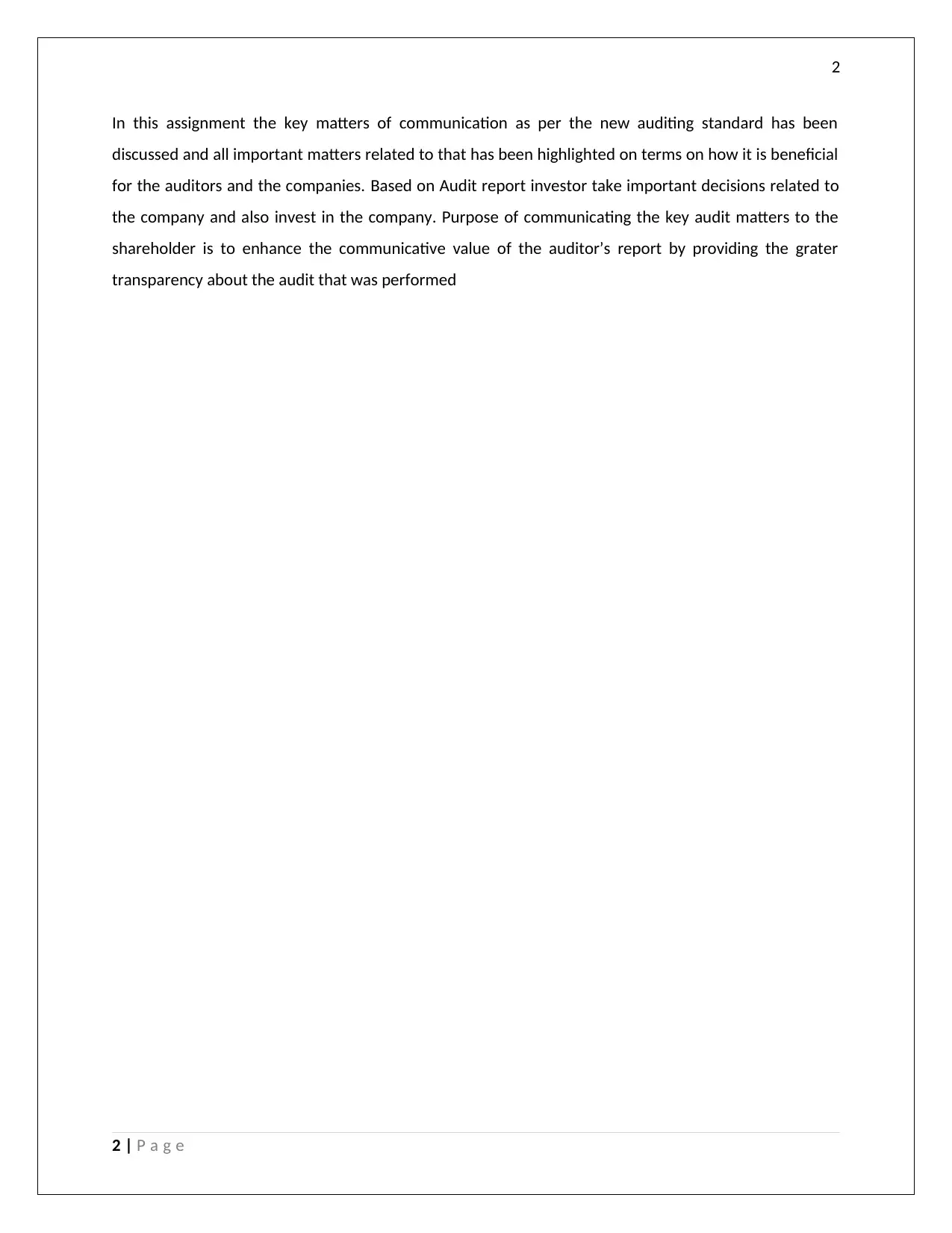
2
In this assignment the key matters of communication as per the new auditing standard has been
discussed and all important matters related to that has been highlighted on terms on how it is beneficial
for the auditors and the companies. Based on Audit report investor take important decisions related to
the company and also invest in the company. Purpose of communicating the key audit matters to the
shareholder is to enhance the communicative value of the auditor’s report by providing the grater
transparency about the audit that was performed
2 | P a g e
In this assignment the key matters of communication as per the new auditing standard has been
discussed and all important matters related to that has been highlighted on terms on how it is beneficial
for the auditors and the companies. Based on Audit report investor take important decisions related to
the company and also invest in the company. Purpose of communicating the key audit matters to the
shareholder is to enhance the communicative value of the auditor’s report by providing the grater
transparency about the audit that was performed
2 | P a g e
⊘ This is a preview!⊘
Do you want full access?
Subscribe today to unlock all pages.

Trusted by 1+ million students worldwide
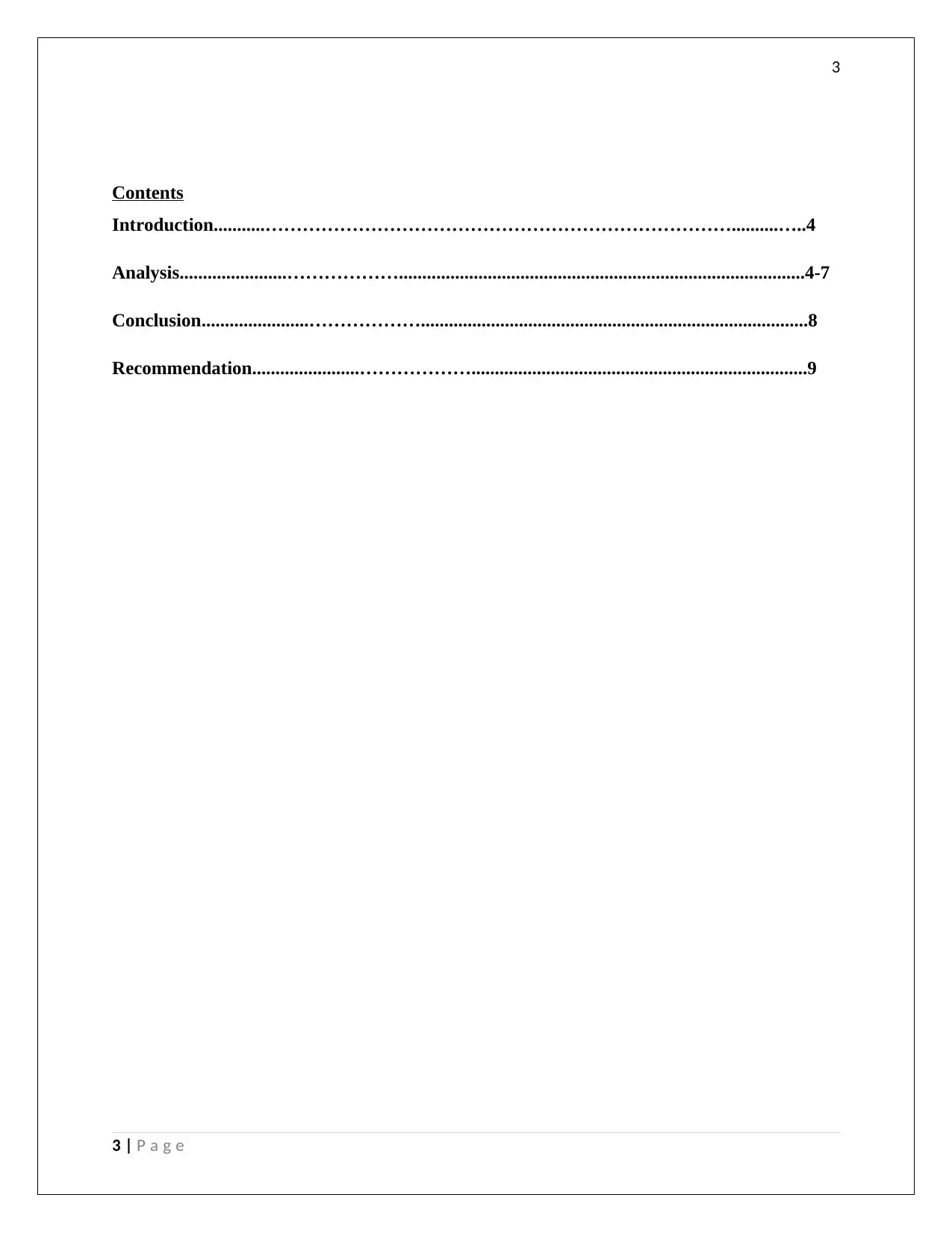
3
Contents
Introduction...........…………………………………………………………………..........…..4
Analysis.......................……………….......................................................................................4-7
Conclusion.......................………………...................................................................................8
Recommendation.......................………………........................................................................9
3 | P a g e
Contents
Introduction...........…………………………………………………………………..........…..4
Analysis.......................……………….......................................................................................4-7
Conclusion.......................………………...................................................................................8
Recommendation.......................………………........................................................................9
3 | P a g e
Paraphrase This Document
Need a fresh take? Get an instant paraphrase of this document with our AI Paraphraser
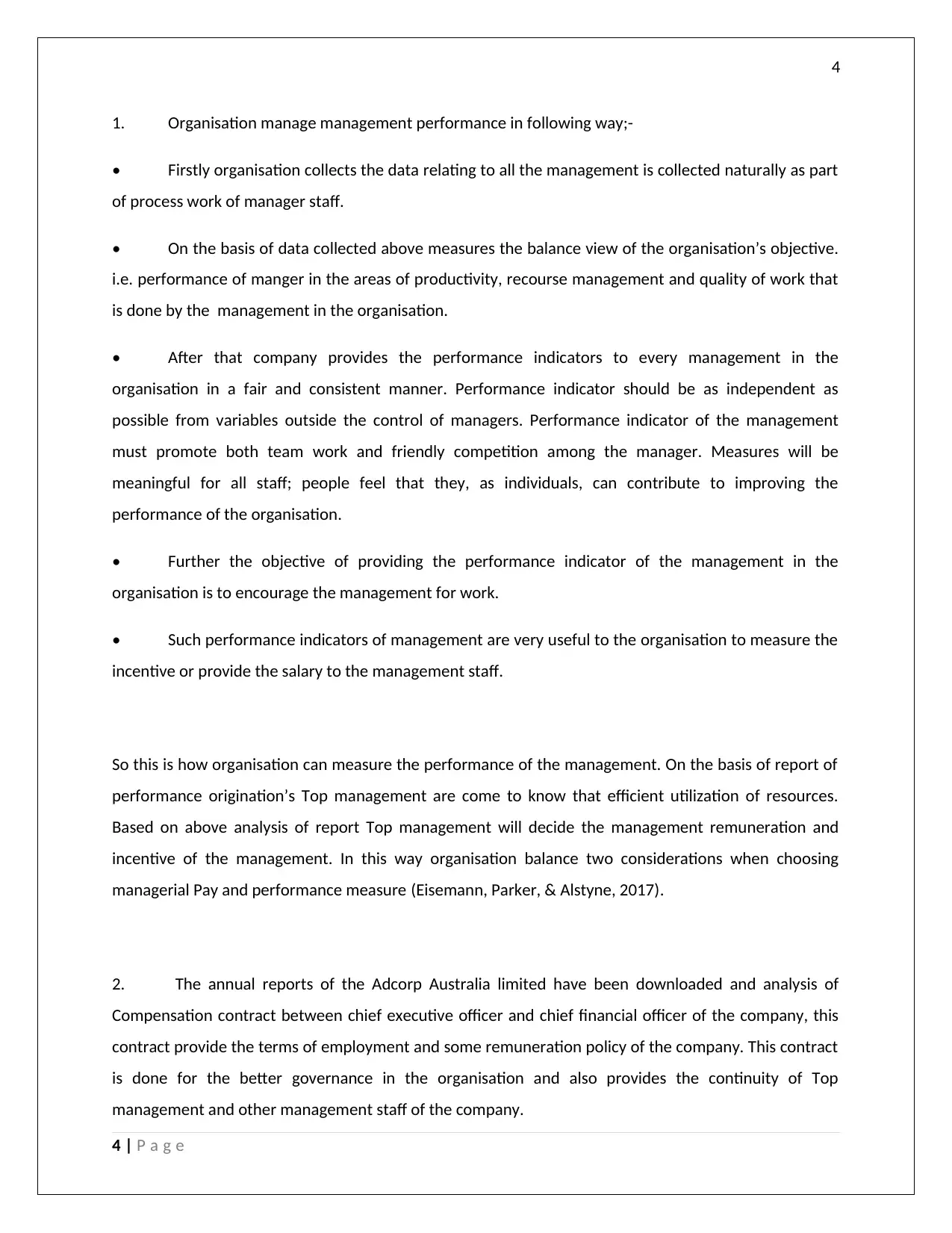
4
1. Organisation manage management performance in following way;-
• Firstly organisation collects the data relating to all the management is collected naturally as part
of process work of manager staff.
• On the basis of data collected above measures the balance view of the organisation’s objective.
i.e. performance of manger in the areas of productivity, recourse management and quality of work that
is done by the management in the organisation.
• After that company provides the performance indicators to every management in the
organisation in a fair and consistent manner. Performance indicator should be as independent as
possible from variables outside the control of managers. Performance indicator of the management
must promote both team work and friendly competition among the manager. Measures will be
meaningful for all staff; people feel that they, as individuals, can contribute to improving the
performance of the organisation.
• Further the objective of providing the performance indicator of the management in the
organisation is to encourage the management for work.
• Such performance indicators of management are very useful to the organisation to measure the
incentive or provide the salary to the management staff.
So this is how organisation can measure the performance of the management. On the basis of report of
performance origination’s Top management are come to know that efficient utilization of resources.
Based on above analysis of report Top management will decide the management remuneration and
incentive of the management. In this way organisation balance two considerations when choosing
managerial Pay and performance measure (Eisemann, Parker, & Alstyne, 2017).
2. The annual reports of the Adcorp Australia limited have been downloaded and analysis of
Compensation contract between chief executive officer and chief financial officer of the company, this
contract provide the terms of employment and some remuneration policy of the company. This contract
is done for the better governance in the organisation and also provides the continuity of Top
management and other management staff of the company.
4 | P a g e
1. Organisation manage management performance in following way;-
• Firstly organisation collects the data relating to all the management is collected naturally as part
of process work of manager staff.
• On the basis of data collected above measures the balance view of the organisation’s objective.
i.e. performance of manger in the areas of productivity, recourse management and quality of work that
is done by the management in the organisation.
• After that company provides the performance indicators to every management in the
organisation in a fair and consistent manner. Performance indicator should be as independent as
possible from variables outside the control of managers. Performance indicator of the management
must promote both team work and friendly competition among the manager. Measures will be
meaningful for all staff; people feel that they, as individuals, can contribute to improving the
performance of the organisation.
• Further the objective of providing the performance indicator of the management in the
organisation is to encourage the management for work.
• Such performance indicators of management are very useful to the organisation to measure the
incentive or provide the salary to the management staff.
So this is how organisation can measure the performance of the management. On the basis of report of
performance origination’s Top management are come to know that efficient utilization of resources.
Based on above analysis of report Top management will decide the management remuneration and
incentive of the management. In this way organisation balance two considerations when choosing
managerial Pay and performance measure (Eisemann, Parker, & Alstyne, 2017).
2. The annual reports of the Adcorp Australia limited have been downloaded and analysis of
Compensation contract between chief executive officer and chief financial officer of the company, this
contract provide the terms of employment and some remuneration policy of the company. This contract
is done for the better governance in the organisation and also provides the continuity of Top
management and other management staff of the company.
4 | P a g e
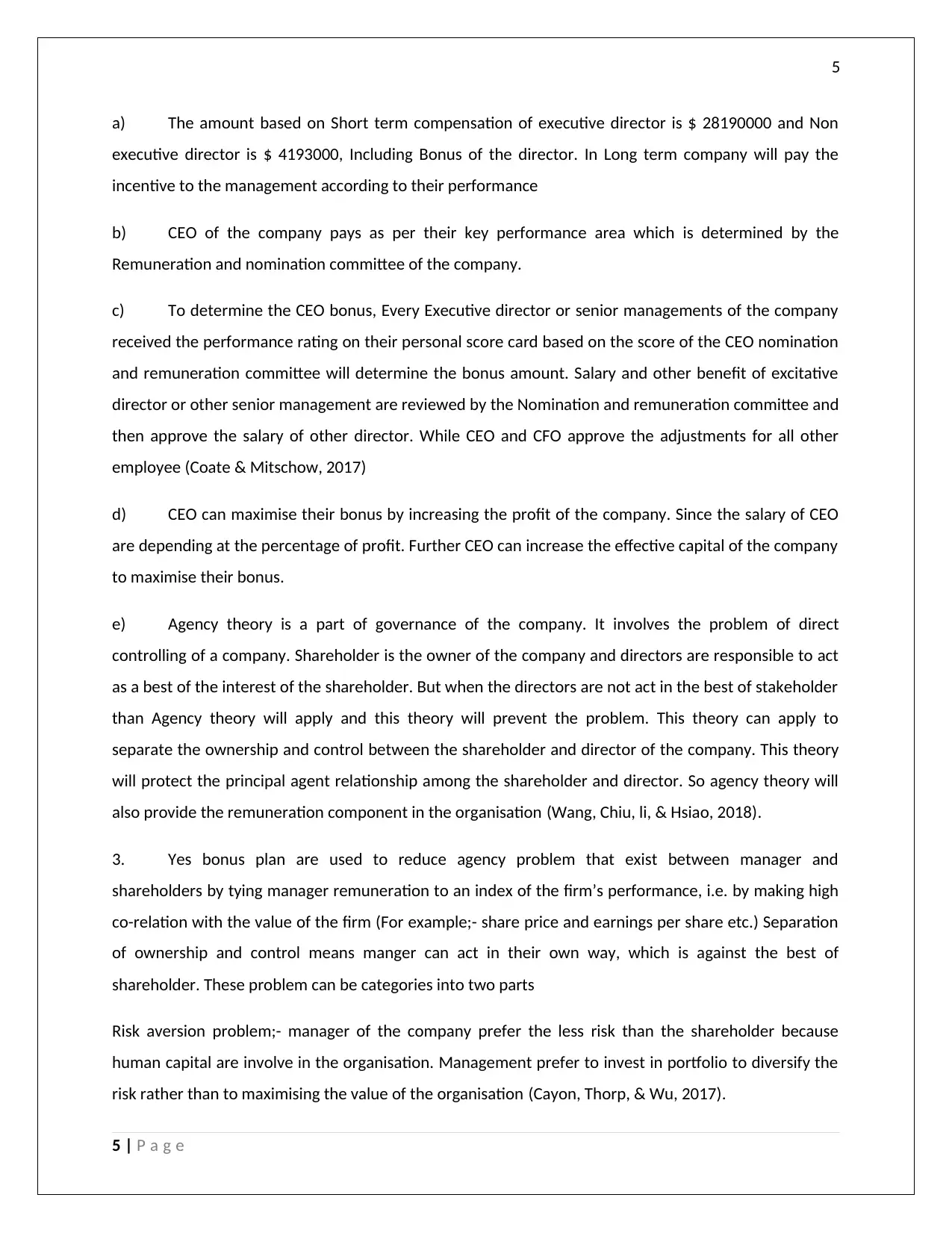
5
a) The amount based on Short term compensation of executive director is $ 28190000 and Non
executive director is $ 4193000, Including Bonus of the director. In Long term company will pay the
incentive to the management according to their performance
b) CEO of the company pays as per their key performance area which is determined by the
Remuneration and nomination committee of the company.
c) To determine the CEO bonus, Every Executive director or senior managements of the company
received the performance rating on their personal score card based on the score of the CEO nomination
and remuneration committee will determine the bonus amount. Salary and other benefit of excitative
director or other senior management are reviewed by the Nomination and remuneration committee and
then approve the salary of other director. While CEO and CFO approve the adjustments for all other
employee (Coate & Mitschow, 2017)
d) CEO can maximise their bonus by increasing the profit of the company. Since the salary of CEO
are depending at the percentage of profit. Further CEO can increase the effective capital of the company
to maximise their bonus.
e) Agency theory is a part of governance of the company. It involves the problem of direct
controlling of a company. Shareholder is the owner of the company and directors are responsible to act
as a best of the interest of the shareholder. But when the directors are not act in the best of stakeholder
than Agency theory will apply and this theory will prevent the problem. This theory can apply to
separate the ownership and control between the shareholder and director of the company. This theory
will protect the principal agent relationship among the shareholder and director. So agency theory will
also provide the remuneration component in the organisation (Wang, Chiu, li, & Hsiao, 2018).
3. Yes bonus plan are used to reduce agency problem that exist between manager and
shareholders by tying manager remuneration to an index of the firm’s performance, i.e. by making high
co-relation with the value of the firm (For example;- share price and earnings per share etc.) Separation
of ownership and control means manger can act in their own way, which is against the best of
shareholder. These problem can be categories into two parts
Risk aversion problem;- manager of the company prefer the less risk than the shareholder because
human capital are involve in the organisation. Management prefer to invest in portfolio to diversify the
risk rather than to maximising the value of the organisation (Cayon, Thorp, & Wu, 2017).
5 | P a g e
a) The amount based on Short term compensation of executive director is $ 28190000 and Non
executive director is $ 4193000, Including Bonus of the director. In Long term company will pay the
incentive to the management according to their performance
b) CEO of the company pays as per their key performance area which is determined by the
Remuneration and nomination committee of the company.
c) To determine the CEO bonus, Every Executive director or senior managements of the company
received the performance rating on their personal score card based on the score of the CEO nomination
and remuneration committee will determine the bonus amount. Salary and other benefit of excitative
director or other senior management are reviewed by the Nomination and remuneration committee and
then approve the salary of other director. While CEO and CFO approve the adjustments for all other
employee (Coate & Mitschow, 2017)
d) CEO can maximise their bonus by increasing the profit of the company. Since the salary of CEO
are depending at the percentage of profit. Further CEO can increase the effective capital of the company
to maximise their bonus.
e) Agency theory is a part of governance of the company. It involves the problem of direct
controlling of a company. Shareholder is the owner of the company and directors are responsible to act
as a best of the interest of the shareholder. But when the directors are not act in the best of stakeholder
than Agency theory will apply and this theory will prevent the problem. This theory can apply to
separate the ownership and control between the shareholder and director of the company. This theory
will protect the principal agent relationship among the shareholder and director. So agency theory will
also provide the remuneration component in the organisation (Wang, Chiu, li, & Hsiao, 2018).
3. Yes bonus plan are used to reduce agency problem that exist between manager and
shareholders by tying manager remuneration to an index of the firm’s performance, i.e. by making high
co-relation with the value of the firm (For example;- share price and earnings per share etc.) Separation
of ownership and control means manger can act in their own way, which is against the best of
shareholder. These problem can be categories into two parts
Risk aversion problem;- manager of the company prefer the less risk than the shareholder because
human capital are involve in the organisation. Management prefer to invest in portfolio to diversify the
risk rather than to maximising the value of the organisation (Cayon, Thorp, & Wu, 2017).
5 | P a g e
⊘ This is a preview!⊘
Do you want full access?
Subscribe today to unlock all pages.

Trusted by 1+ million students worldwide
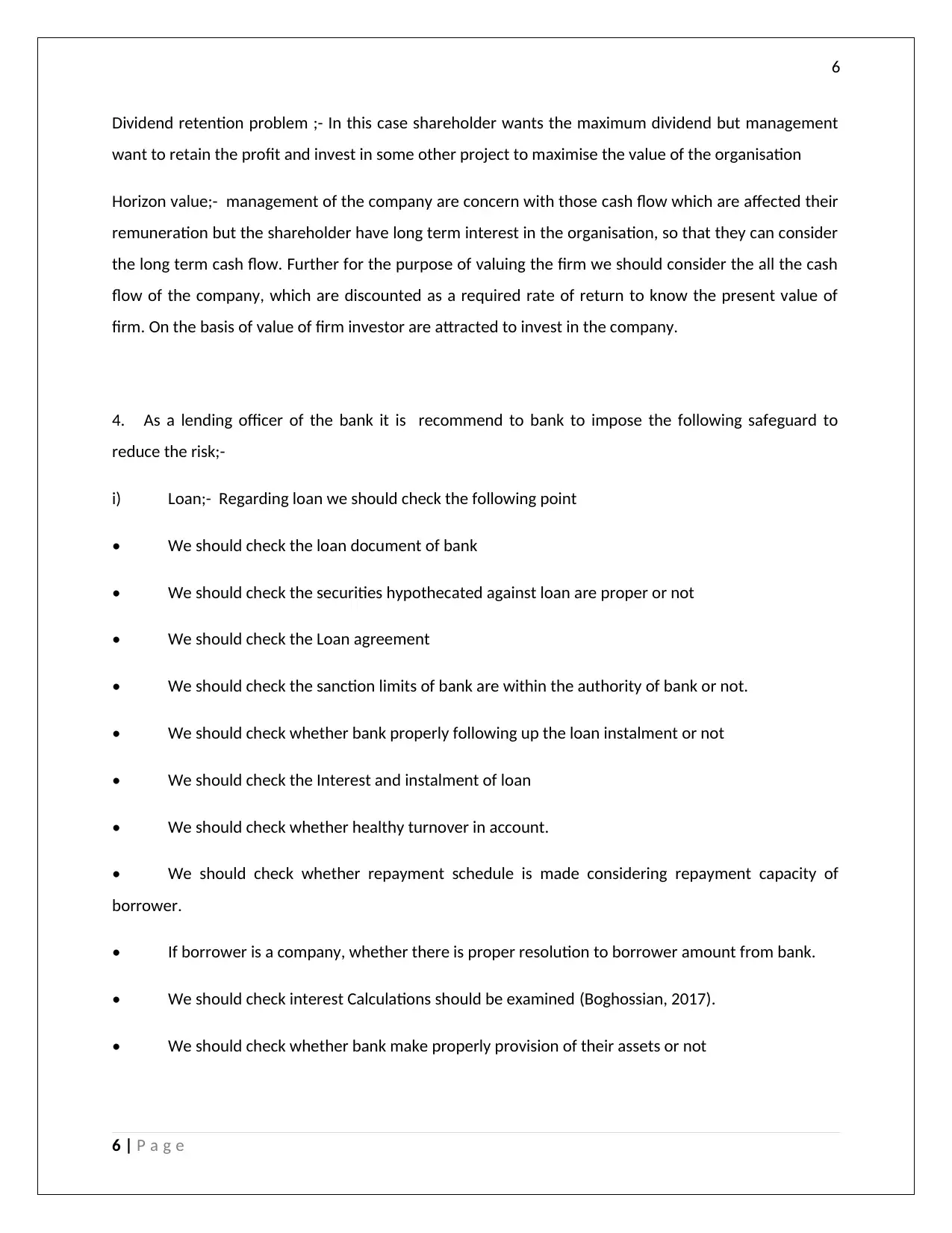
6
Dividend retention problem ;- In this case shareholder wants the maximum dividend but management
want to retain the profit and invest in some other project to maximise the value of the organisation
Horizon value;- management of the company are concern with those cash flow which are affected their
remuneration but the shareholder have long term interest in the organisation, so that they can consider
the long term cash flow. Further for the purpose of valuing the firm we should consider the all the cash
flow of the company, which are discounted as a required rate of return to know the present value of
firm. On the basis of value of firm investor are attracted to invest in the company.
4. As a lending officer of the bank it is recommend to bank to impose the following safeguard to
reduce the risk;-
i) Loan;- Regarding loan we should check the following point
• We should check the loan document of bank
• We should check the securities hypothecated against loan are proper or not
• We should check the Loan agreement
• We should check the sanction limits of bank are within the authority of bank or not.
• We should check whether bank properly following up the loan instalment or not
• We should check the Interest and instalment of loan
• We should check whether healthy turnover in account.
• We should check whether repayment schedule is made considering repayment capacity of
borrower.
• If borrower is a company, whether there is proper resolution to borrower amount from bank.
• We should check interest Calculations should be examined (Boghossian, 2017).
• We should check whether bank make properly provision of their assets or not
6 | P a g e
Dividend retention problem ;- In this case shareholder wants the maximum dividend but management
want to retain the profit and invest in some other project to maximise the value of the organisation
Horizon value;- management of the company are concern with those cash flow which are affected their
remuneration but the shareholder have long term interest in the organisation, so that they can consider
the long term cash flow. Further for the purpose of valuing the firm we should consider the all the cash
flow of the company, which are discounted as a required rate of return to know the present value of
firm. On the basis of value of firm investor are attracted to invest in the company.
4. As a lending officer of the bank it is recommend to bank to impose the following safeguard to
reduce the risk;-
i) Loan;- Regarding loan we should check the following point
• We should check the loan document of bank
• We should check the securities hypothecated against loan are proper or not
• We should check the Loan agreement
• We should check the sanction limits of bank are within the authority of bank or not.
• We should check whether bank properly following up the loan instalment or not
• We should check the Interest and instalment of loan
• We should check whether healthy turnover in account.
• We should check whether repayment schedule is made considering repayment capacity of
borrower.
• If borrower is a company, whether there is proper resolution to borrower amount from bank.
• We should check interest Calculations should be examined (Boghossian, 2017).
• We should check whether bank make properly provision of their assets or not
6 | P a g e
Paraphrase This Document
Need a fresh take? Get an instant paraphrase of this document with our AI Paraphraser
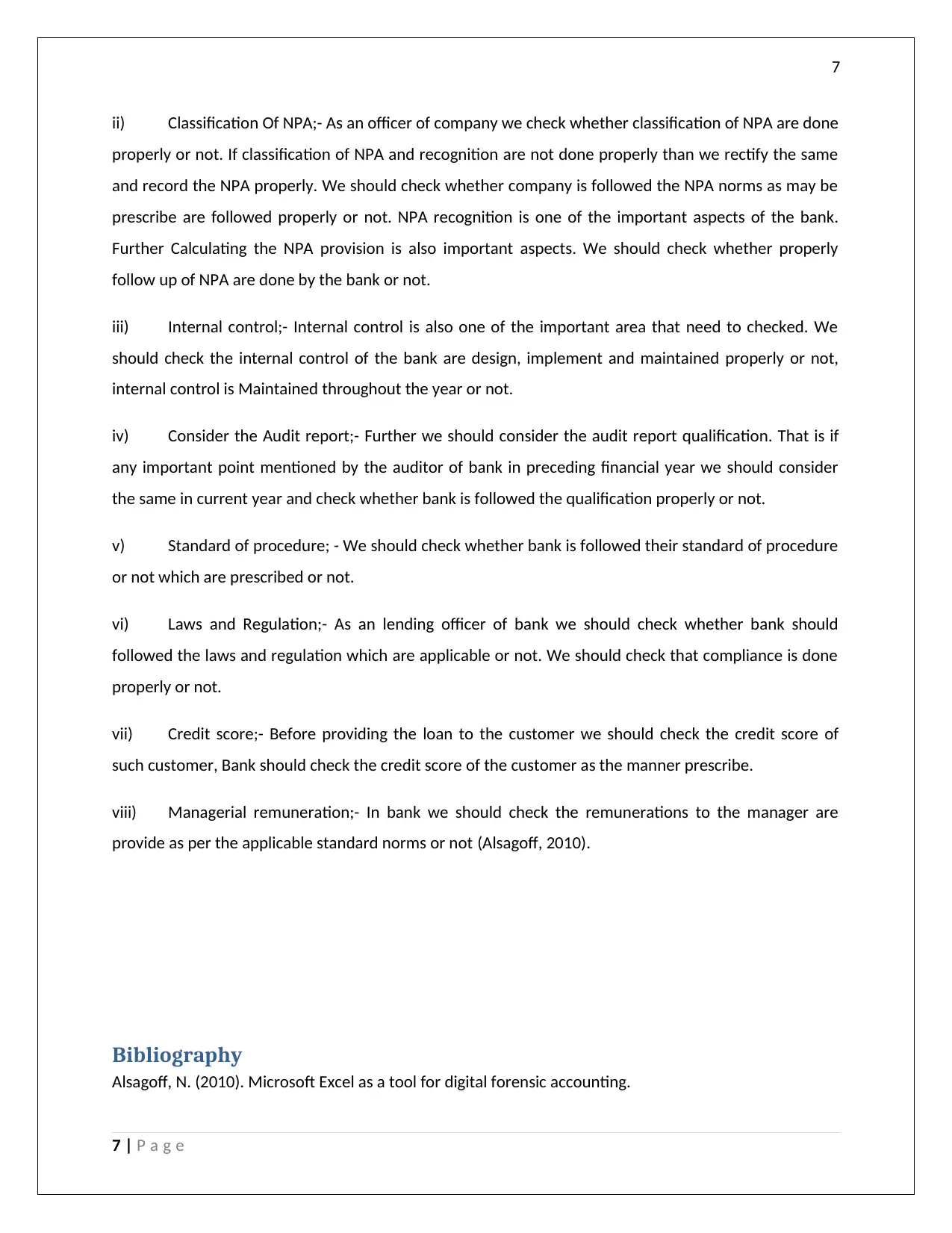
7
ii) Classification Of NPA;- As an officer of company we check whether classification of NPA are done
properly or not. If classification of NPA and recognition are not done properly than we rectify the same
and record the NPA properly. We should check whether company is followed the NPA norms as may be
prescribe are followed properly or not. NPA recognition is one of the important aspects of the bank.
Further Calculating the NPA provision is also important aspects. We should check whether properly
follow up of NPA are done by the bank or not.
iii) Internal control;- Internal control is also one of the important area that need to checked. We
should check the internal control of the bank are design, implement and maintained properly or not,
internal control is Maintained throughout the year or not.
iv) Consider the Audit report;- Further we should consider the audit report qualification. That is if
any important point mentioned by the auditor of bank in preceding financial year we should consider
the same in current year and check whether bank is followed the qualification properly or not.
v) Standard of procedure; - We should check whether bank is followed their standard of procedure
or not which are prescribed or not.
vi) Laws and Regulation;- As an lending officer of bank we should check whether bank should
followed the laws and regulation which are applicable or not. We should check that compliance is done
properly or not.
vii) Credit score;- Before providing the loan to the customer we should check the credit score of
such customer, Bank should check the credit score of the customer as the manner prescribe.
viii) Managerial remuneration;- In bank we should check the remunerations to the manager are
provide as per the applicable standard norms or not (Alsagoff, 2010).
Bibliography
Alsagoff, N. (2010). Microsoft Excel as a tool for digital forensic accounting.
7 | P a g e
ii) Classification Of NPA;- As an officer of company we check whether classification of NPA are done
properly or not. If classification of NPA and recognition are not done properly than we rectify the same
and record the NPA properly. We should check whether company is followed the NPA norms as may be
prescribe are followed properly or not. NPA recognition is one of the important aspects of the bank.
Further Calculating the NPA provision is also important aspects. We should check whether properly
follow up of NPA are done by the bank or not.
iii) Internal control;- Internal control is also one of the important area that need to checked. We
should check the internal control of the bank are design, implement and maintained properly or not,
internal control is Maintained throughout the year or not.
iv) Consider the Audit report;- Further we should consider the audit report qualification. That is if
any important point mentioned by the auditor of bank in preceding financial year we should consider
the same in current year and check whether bank is followed the qualification properly or not.
v) Standard of procedure; - We should check whether bank is followed their standard of procedure
or not which are prescribed or not.
vi) Laws and Regulation;- As an lending officer of bank we should check whether bank should
followed the laws and regulation which are applicable or not. We should check that compliance is done
properly or not.
vii) Credit score;- Before providing the loan to the customer we should check the credit score of
such customer, Bank should check the credit score of the customer as the manner prescribe.
viii) Managerial remuneration;- In bank we should check the remunerations to the manager are
provide as per the applicable standard norms or not (Alsagoff, 2010).
Bibliography
Alsagoff, N. (2010). Microsoft Excel as a tool for digital forensic accounting.
7 | P a g e
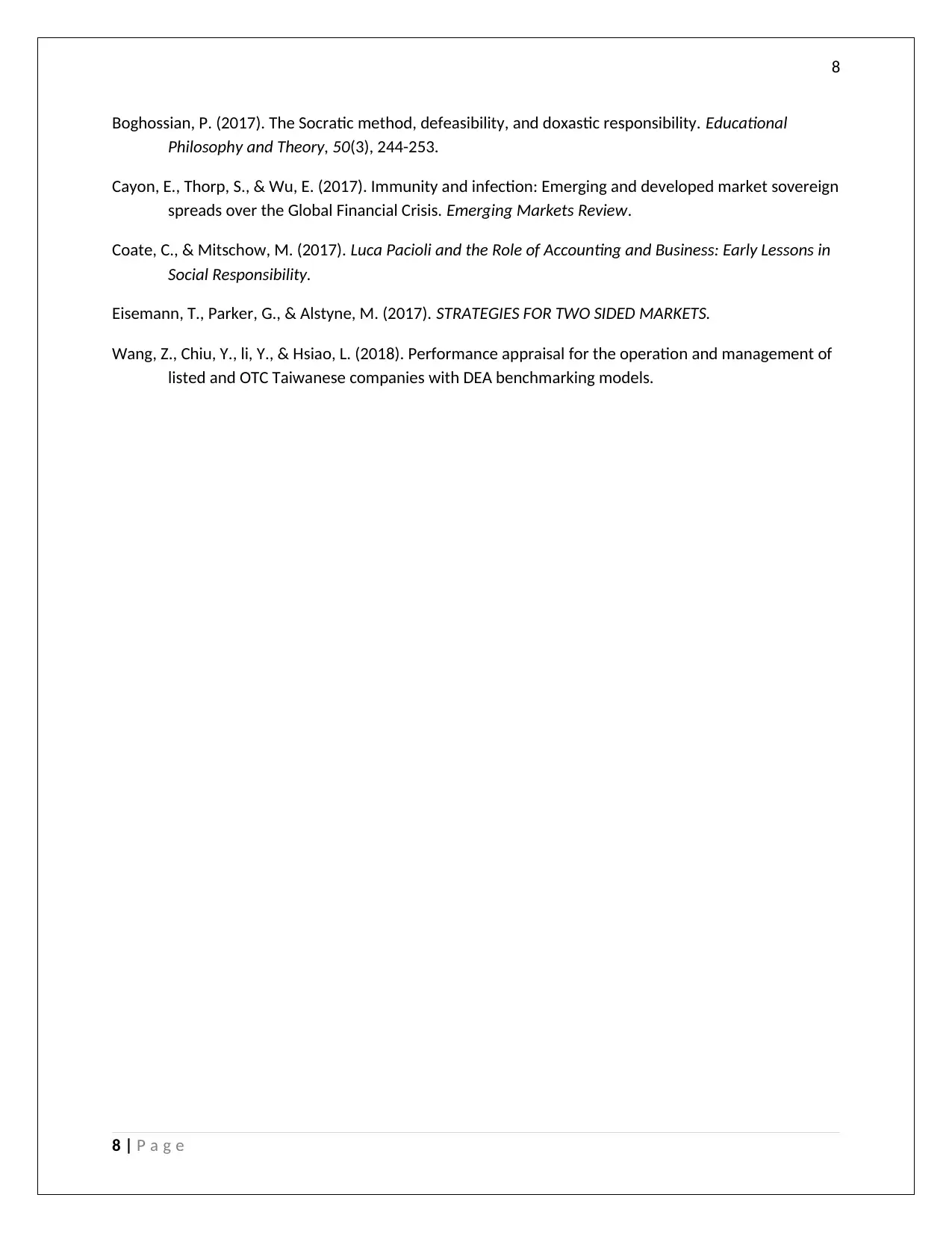
8
Boghossian, P. (2017). The Socratic method, defeasibility, and doxastic responsibility. Educational
Philosophy and Theory, 50(3), 244-253.
Cayon, E., Thorp, S., & Wu, E. (2017). Immunity and infection: Emerging and developed market sovereign
spreads over the Global Financial Crisis. Emerging Markets Review.
Coate, C., & Mitschow, M. (2017). Luca Pacioli and the Role of Accounting and Business: Early Lessons in
Social Responsibility.
Eisemann, T., Parker, G., & Alstyne, M. (2017). STRATEGIES FOR TWO SIDED MARKETS.
Wang, Z., Chiu, Y., li, Y., & Hsiao, L. (2018). Performance appraisal for the operation and management of
listed and OTC Taiwanese companies with DEA benchmarking models.
8 | P a g e
Boghossian, P. (2017). The Socratic method, defeasibility, and doxastic responsibility. Educational
Philosophy and Theory, 50(3), 244-253.
Cayon, E., Thorp, S., & Wu, E. (2017). Immunity and infection: Emerging and developed market sovereign
spreads over the Global Financial Crisis. Emerging Markets Review.
Coate, C., & Mitschow, M. (2017). Luca Pacioli and the Role of Accounting and Business: Early Lessons in
Social Responsibility.
Eisemann, T., Parker, G., & Alstyne, M. (2017). STRATEGIES FOR TWO SIDED MARKETS.
Wang, Z., Chiu, Y., li, Y., & Hsiao, L. (2018). Performance appraisal for the operation and management of
listed and OTC Taiwanese companies with DEA benchmarking models.
8 | P a g e
⊘ This is a preview!⊘
Do you want full access?
Subscribe today to unlock all pages.

Trusted by 1+ million students worldwide

9
9 | P a g e
9 | P a g e
1 out of 10
Related Documents
Your All-in-One AI-Powered Toolkit for Academic Success.
+13062052269
info@desklib.com
Available 24*7 on WhatsApp / Email
![[object Object]](/_next/static/media/star-bottom.7253800d.svg)
Unlock your academic potential
Copyright © 2020–2025 A2Z Services. All Rights Reserved. Developed and managed by ZUCOL.





